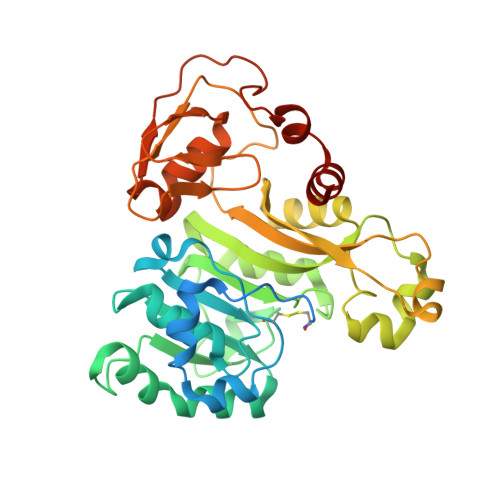A disulfide-bond cascade mechanism for arsenic(III) S-adenosylmethionine methyltransferase.
Marapakala, K., Packianathan, C., Ajees, A.A., Dheeman, D.S., Sankaran, B., Kandavelu, P., Rosen, B.P.(2015) Acta Crystallogr D Biol Crystallogr 71: 505-515
- PubMed: 25760600
- DOI: https://doi.org/10.1107/S1399004714027552
- Primary Citation of Related Structures:
4KW7, 4RSR - PubMed Abstract:
Methylation of the toxic metalloid arsenic is widespread in nature. Members of every kingdom have arsenic(III) S-adenosylmethionine (SAM) methyltransferase enzymes, which are termed ArsM in microbes and AS3MT in animals, including humans. Trivalent arsenic(III) is methylated up to three times to form methylarsenite [MAs(III)], dimethylarsenite [DMAs(III)] and the volatile trimethylarsine [TMAs(III)]. In microbes, arsenic methylation is a detoxification process. In humans, MAs(III) and DMAs(III) are more toxic and carcinogenic than either inorganic arsenate or arsenite. Here, new crystal structures are reported of ArsM from the thermophilic eukaryotic alga Cyanidioschyzon sp. 5508 (CmArsM) with the bound aromatic arsenicals phenylarsenite [PhAs(III)] at 1.80 Å resolution and reduced roxarsone [Rox(III)] at 2.25 Å resolution. These organoarsenicals are bound to two of four conserved cysteine residues: Cys174 and Cys224. The electron density extends the structure to include a newly identified conserved cysteine residue, Cys44, which is disulfide-bonded to the fourth conserved cysteine residue, Cys72. A second disulfide bond between Cys72 and Cys174 had been observed previously in a structure with bound SAM. The loop containing Cys44 and Cys72 shifts by nearly 6.5 Å in the arsenic(III)-bound structures compared with the SAM-bound structure, which suggests that this movement leads to formation of the Cys72-Cys174 disulfide bond. A model is proposed for the catalytic mechanism of arsenic(III) SAM methyltransferases in which a disulfide-bond cascade maintains the products in the trivalent state.
- Department of Chemistry, Osmania University College for Women, Osmania University, Hyderabad 500 095, India.
Organizational Affiliation:


















